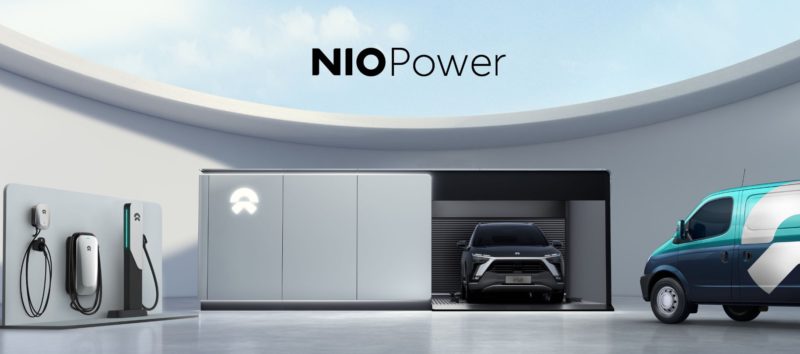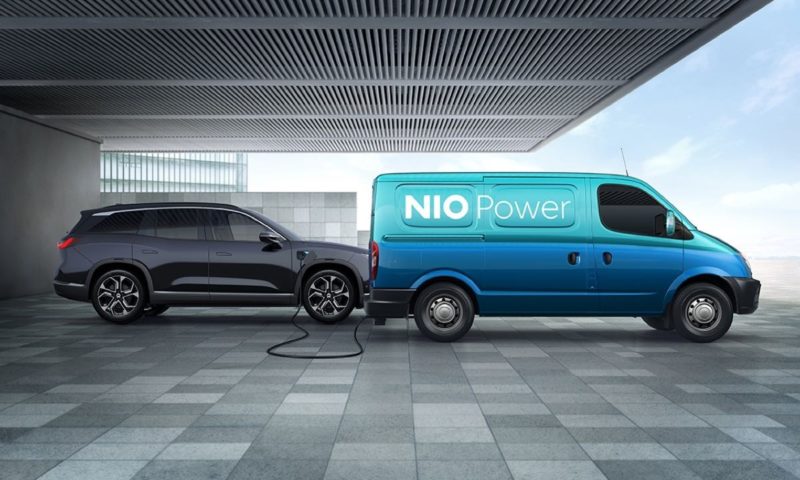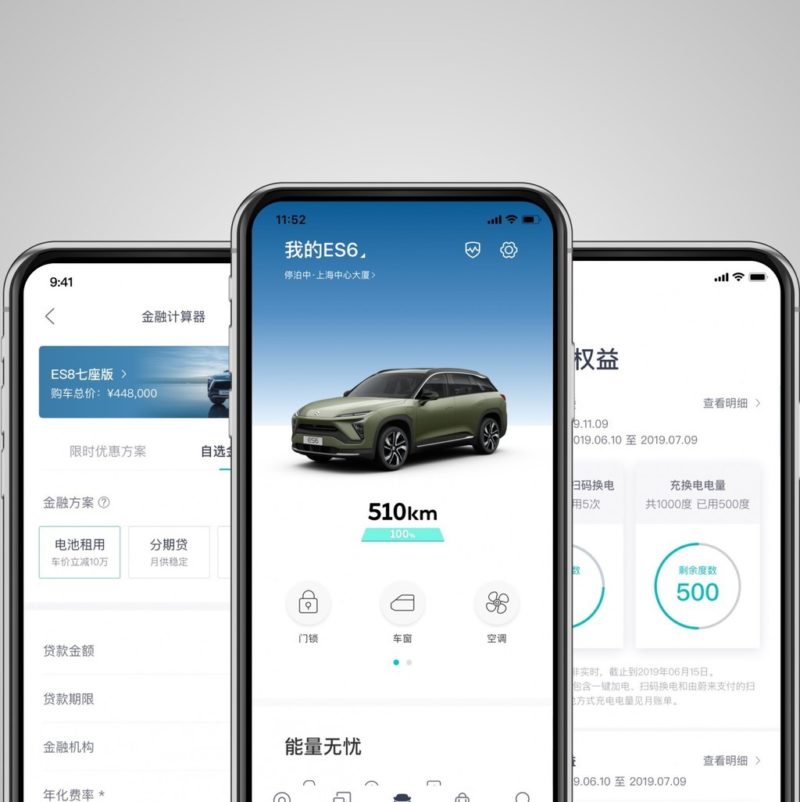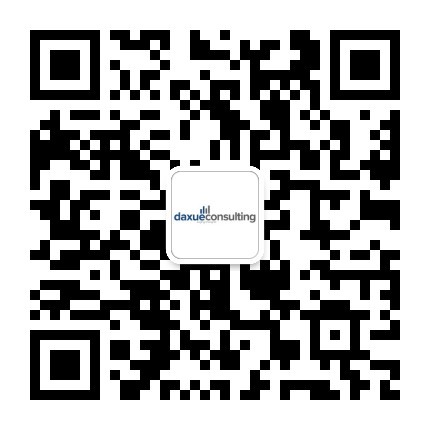NIO (蔚来汽车, which translates to “Blue Sky Coming”) is a leading premium EV maker in China. As a young company founded in 2014 by William Li, who is dubbed the “Elon Musk of China”, NIO has received investment from tech giants like Tencent and Baidu and has eventually become the leader in China’s homegrown EV industry. The company’s stock price skyrocketed in the second half of 2020, making the company the fifth biggest automaker in the world by the market capitalization.
NIO’s success didn’t only come from the movement of the capital market, this young homegrown company has been able to shake Tesla’s dominance in the price range and attract attention of traditional premium automakers’ target customers. NIO’s innovations in design, services, and financing have won itself the title of “China’s Tesla” for investors and EV enthusiasts alike.
The “golden child” in the Chinese EV industry
NIO is currently the biggest homegrown new generation EV maker in China, contributing to 16% of the sales share in the first half of 2020, according to a GF Securities report. With the plan to enter Europe in 2021, NIO has emerged as the “golden child”, whose success illustrates the growth of the Chinese EV industry.

Source: GF Securities, designed by Daxue Consulting, Sales share of Chinese EV new forces in the first half of 2020
As a homegrown company with cooperation with Chinese local governments and JAC Motors, a leading state-own automotive manufacturer, NIO is likely to be benefited from its status as a Chinese homegrown enterprise. After the financial setback in the early 2020, which almost brought the company into bankruptcy, the company managed to secure a government bailout worth 1.4 billion USD. Such an example demonstrates its advantage in China as the leading company of the industry. Although Tesla is still leading in the Chinese EV market, NIO has the potential to challenge its dominance.
SUVs and more: from avoiding Tesla to embracing Tesla’s dominance

Source: NIO website & Tesla website, designed by Daxue Consulting, Comparison between models of NIO and Tesla
In the initial phase, the Chinese electric vehicle maker focused on the premium SUV segment, one of the most popular among Chinese customers. After the development of EP6, the choice of segment helps NIO to avoid direct competition with Tesla, as its crossover SUV models Model X and Model Y were more expensive than ES8 and ES6. However, after Tesla substantially lowered Model Y’s price in China to be cheaper than ES6 in the beginning of 2021, ES6 and newer crossover EC6 is now in direct competition against Model Y in the mid-size SUV segment.
Since 2020, NIO entered the premium sedan segment by launching ET7, which has similar specs with Tesla’s model S but with a significantly lower retail price. As it has consolidated its brand value, it will create substantial threats to other homegrown EV makers and even challenge Tesla’s dominance in all popular segments in China.
Innovative battery solutions

Source: brand official website, NIO Power
Battery leasing: Premium electric vehicles with affordable prices
The battery is the most expensive component in electric vehicles, usually making up to a third and even a half of the costs. To decrease the financial burden on consumers, the Chinese EV maker provides battery leasing option. When choosing to lease the battery buyers can save up to 128 thousand RMB, as much as a third of the full price of some models. Considering NIO’s competition with other luxury automakers, the battery leasing option would allow NIO to be competitive in its pricing. The owners who opt in the battery leasing option would subsequently pay 980 RMB or 1,480 RMB per month to rent the battery.
Battery swap: What Tesla couldn’t achieve
In 2013, Elon Musk demonstrated the ambitious battery swap technology, changing Tesla Model S’s battery in just 90 seconds. However, what he envisioned has never been realized for Tesla, while NIO has successfully constructed a relatively matured model and built a wide battery swap network in China. As of September 2020 , the Chinese EV maker has built a network of 155 battery swap stations in China and plans to increase the number to more than 300 by 2021. According to NIO’s website, the battery swap stations are currently available in 20 cities and 6 highways. The current policy allows all the owners of ES6 and ES8 use the battery swap services unlimitedly for the car’s whole life cycle.

Source: Brand official website, “Battery replacement mode” a feature of electric vehicles manufactured in China
NIO owners can swap their batteries within as little as three minutes at one of the stations. On Zhihu, a NIO owner shares his positive experience with battery swap. According to the user, the service supplements the charging stations in the urban areas. “When no one is in the queue, the whole process takes less than 5 minutes. Even when there is a queue, it usually takes less than 20 minutes.” He also points out the option’s superiority in highways, comparing to charging, which takes more than 90 minutes to fully recharge a car even with fast charging. He describes battery swap as similar to “traditional fueling”, but without “the unpleasant smell from gas.”
One Click for Power: “Charging” your EV from a smartphone
The Chinese EV brand provides many services that enhance user experiences. One of the most popular services is the NIO Power’s One Click for Power – advertised as “24/7 On-Call Valet Charging” on its website. On NIO app, the user requests the service and NIO Power will pick up the car at the location requested and return the car to the same location after fully recharged with a short time frame, usually within four hours. The company optimized the waiting time by choosing charging options based on algorithms, either by battery swap or charger.
When the car runs out of battery at locations where the battery swap or charging facilities are not available, the user can even request a Power Mobile service on phone. The company will come to the location requested with a van equipped with charging capability. According to the website, the EV can receive 100 km range after 10 minute charge through Power Mobile, which is like a “a flexible and convenient portable power bank to your car”.

Source: NIO Website, NIO Power Mobile
NIO’s ecosystem: More than just an automaker
The NIO app
Automakers are directing more resources into adding mobile phones into the car’s ecosystem, allowing car owners to use their phones to realize functions in car and even when away from the car. NIO as a new generation EV manufacturer with “Internet DNA” is not an exception; its app offers a wide range of functions and many of them are conventional.

Source: Brand official Website, NIO App
The NIO app is fully equipped with regular functions such as information about charging and battery swap facilities, over-the-air updates, car unlocking and temperature control. At the same time, the app has been regularly updated to provide more features to improve the user experience, such as a reminder to close the window when it’s raining and allowing owners to temporary authorize another app user to access the vehicle. Through constant detail-oriented innovations, NIO is able to provide its users experiences that many traditional automakers struggle to achieve through their mobile apps.
NIO even goes a step ahead to incorporate features of social media and ecommerce into the app. According to feedback of the users, the app has high user stickiness because of the community dimension it creates. NIO owners and potential buyers, EV enthusiasts, and even company officials regularly use the platform to share their experiences with the brand and the EV industries. Many users comment that the information on the platform, even those which expose the car’s problems and criticize the brand, are rarely censored; many times, the EV’s system updates directly address the feedback seen on the platforms.
NIO House: creating a community
As a relatively new brand, NIO has been able to successfully build its customer loyalty, and NIO House plays an important role. According to its website, NIO House is “space for NIO’s users and friends” and “a joyful lifestyle beyond the car”. While its competitors such as Tesla and Xpeng have been shifting their presence to online as cost saving measures, NIO still very much emphasizes the customer experience in its physical locations. Compared to traditional automakers, NIO is able to upgrade the owners offline experience to a new level, not just as a showroom and a repair center, but as a community. NIO House is similar to a clubhouse exclusive to NIO customers, in where meeting spaces are provided and activities are organized for customers and their children.

Source: NIO Website, NIO House
Even though the NIO House is highly praised by NIO owners, it can only justify the operational costs for its presence in cities with high concentration of NIO customers. NIO’s offline presence is currently mainly driven by the expansion of NIO Space – smaller Tesla-liked showroom. As of the beginning of 2020, there were 22 NIO Houses and 55 NIO Spaces in 57 cities.
Learn something new? Stay updated on the Chinese market by following our WeChat, scan the QR code below, or subscribe to our newsletter

Listen to over 100 China entrepreneur stories on China Paradigms, the China business podcast
Listen to China Paradigm on Apple Podcast






